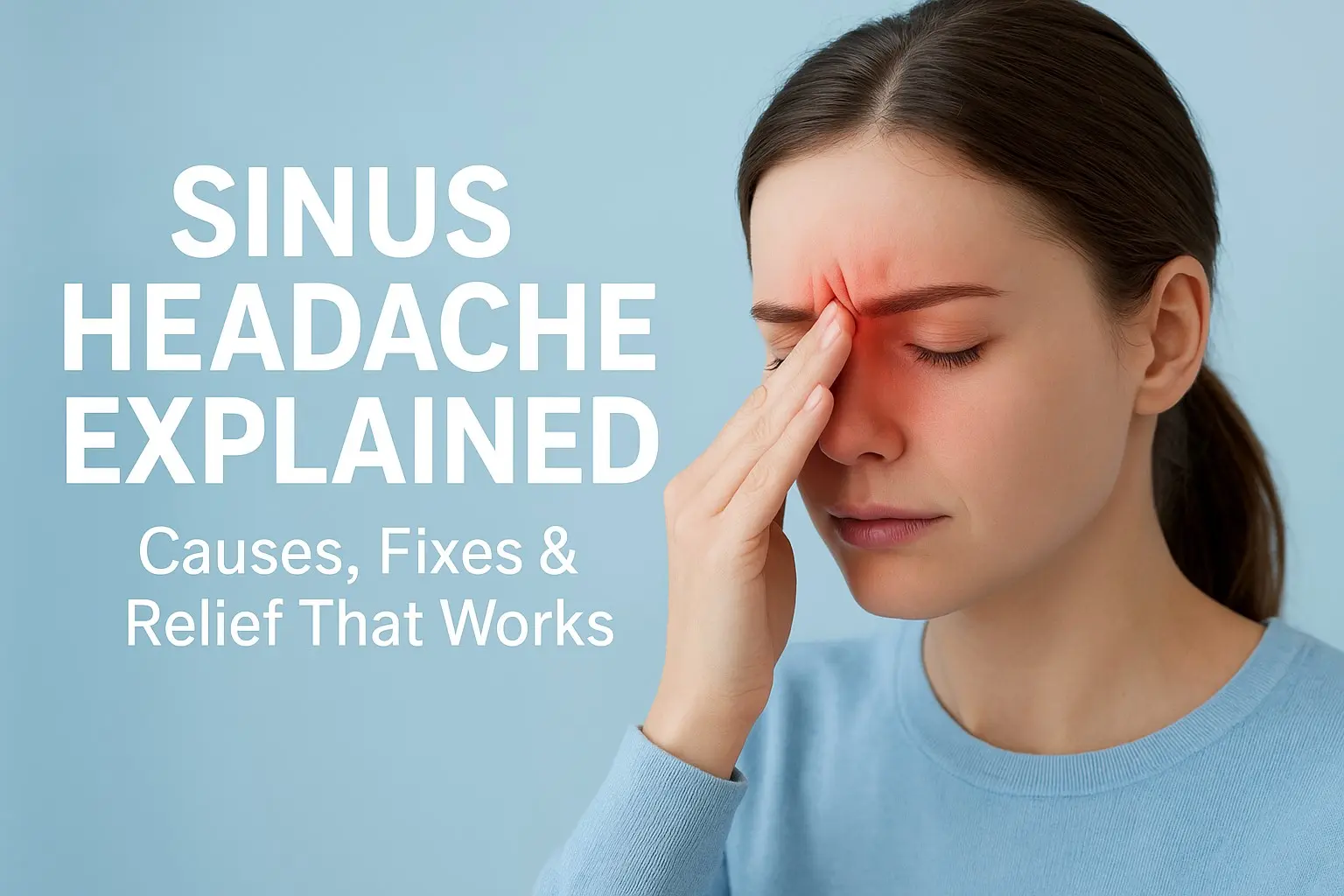A sinus headache can feel like a heavy cloud over your face. It brings throbbing pain, stuffiness, and fatigue that can ruin your day. The good news? You can find sinus pain relief with easy home fixes like steam or hydration, and know when to see a doctor. This guide uses simple words to explain sinusitis headache causes, symptoms, and treatments, so you can feel better fast and keep pain away.
What Is a Sinus Headache?
Headache from sinusitis happens when your sinuses—small air pockets in your forehead, cheeks, and behind your eyes—get swollen. This swelling causes pain, often in your face or head. I’ve felt that tight, achy sinus pressure and headache before, and it’s no picnic! Many think it’s just a regular headache, but it’s often tied to sinus infection, headache or allergies. Knowing what’s happening helps you fix it right.
Why It’s a Big Deal
- Sinus headache symptoms can be confused with migraines, per *Mayo Clinic* (2024).
- Quick action stops pain from getting worse.
- Untreated sinus issues can lead to infections.
Key Fact: Up to 85% of “Sinus Pressure Headache” are migraines, according to 2025 research. This mix-up can delay relief.
How Sinuses Work
Your sinuses are like tiny caves in your face. They:
- Keep your nose moist.
- Lighten your skull.
- Help your voice sound clear.
When they’re blocked, pressure builds, causing facial pain from the sinuses. I like this explanation because it makes science feel simple.
Causes of Sinus Headaches
Its causes are often tied to swelling in the sinuses. Here’s what can trigger it:
- Infections: Germs like viruses or bacteria cause sinus infections and headaches.
- Allergies: Pollen, dust, or pet dander led to nasal congestion and headache.
- Weather Changes: Cold, dry, or humid air irritates sinuses.
- Colds: A stuffy nose adds pressure.
- Other Factors: Dehydration, stress, or smoking can worsen it.
I’ve noticed my sinus headache flares when pollen is high or I skip water. Ever feel that? Recent 2025 studies suggest poor air quality, like indoor pollutants, may also play a role.
Triggers to Watch Out For
- Dust mites in bedding
- Dry air from heaters
- Seasonal allergies (spring or fall)
Actionable Tip: Keep a small notebook or phone app to track when your sinus headache starts. It helps you spot triggers like the weather or allergies.
Key Fact Box:
- Top Cause: Sinus infections or allergies.
- Sneaky Trigger: Dry air in winter.
- New Insight: Air purifiers may lower risks, according to 2025 studies.
Sinus Headache Symptoms: Spot Them Early
Sinus pressure headache symptoms are easy to spot if you know what to look for:
- Pain in the forehead, cheeks, or sinus headache behind the eyes
- Worse pain when bending over or lying down
- Stuffy or runny nose
- Feeling tired or foggy
- Mild fever (if infection is present)
- Thick, yellow, or green mucus
Sinus Headache vs Migraine: Key Differences
A sinus headache vs migraine can be confusing. Here’s how to tell:
- Sinus Pressure Headache: Comes with stuffy nose, facial pain, and no nausea.
- Migraine: One-sided throbbing, light sensitivity, no nasal issues.
I’ve seen friends think their pain was sinus pressure pain when it was a migraine. Getting it wrong delays help!
Early Signs of a Sinus Infection
What are the first signs of a sinus infection? Watch for:
- Stuffy nose for days
- Thick mucus
- Mild face pain or pressure
Tip: If your nose is clear but your head throbs, it’s likely not a sinus headache. Check with a doctor to be sure.
How Doctors Diagnose Sinus Headaches
Doctors use simple tests to confirm a headache from sinusitis. They may:
- Check Your Face: Press cheeks or forehead for tenderness.
- Look in Your Nose: Check for swelling or mucus.
- Order a CT scan: Shows blocked sinuses (used rarely).
- Test for Allergies: If facial pain sinus is allergy-related.
- Blood Tests: Rule out other infections (less common).
What to Expect at the Doctor’s
Doctors will ask:
- When did the pain start?
- Do you have a stuffy nose?
- Any recent colds or allergies?
I’ve tested keeping a symptom list on my phone, and it makes doctor visits so smooth!
Actionable Tip: Write down your symptoms (like pain timing or mucus color) before your visit. It helps doctors figure out if it’s a sinus headache.
Treatment for Sinus Headache: Proven Fixes
Sinus pressure headache treatment options range from home remedies to medical help. Here’s what works:
1. Sinus Headache Relief Home Remedies
- Steam Inhalation: Breathe steam from a hot shower or bowl. It loosens mucus.
- Warm Compress: Place a warm cloth on your face for 10-15 minutes.
- Hydration: Drink 8-10 cups of water daily to thin mucus.
- Saline Nasal Spray: Clears your nose safely.
I love a warm compress because it feels like a hug for my face! [This adds warmth.]
2. Over-the-Counter Meds
- – Decongestants: Like pseudoephedrine, reduce swelling.
- – Pain Relievers: Ibuprofen or acetaminophen eases sinus pressure symptoms.
- – Antihistamines: Help if allergies cause nasal congestion and headache.
Note: Always check with a doctor before giving meds to kids.
3. Medical Treatments
For severe cases:
- Prescription Meds: Stronger antihistamines or steroids.
- Antibiotics: If a bacterial sinus infection headache is confirmed.
- Allergy Shots: For chronic allergy-driven pain.
How to Prevent Sinus Headaches
You can lower chronic headaches from sinus infection with these steps:
- Clean Air: Use an air purifier to remove dust or pollen.
- Stay Hydrated: Drink water all day to keep sinuses moist.
- Nasal Rinse: Use a neti pot with sterile water weekly.
- Manage Stress: Try deep breathing or yoga to relax.
- Avoid Triggers: Stay away from smoke or strong perfumes.
Myth Buster: Cold weather doesn’t cause sinus headaches. Dry air or allergies are bigger culprits!
Actionable Tip: Add a humidifier to your bedroom. I’ve tested this, and it cuts morning sinus pain and congestion in half.
Long-Term Relief: Living Without Sinus Headaches
Most headaches from Sinus Infection clear up with treatment. For ongoing chronic sinus pain issues, try:
- Allergy Management: Get tested for triggers like pollen or dust.
- Healthy Diet: Eat vitamin C-rich foods like oranges or berries.
- Exercise: Light walks improve airflow and reduce stress.
- Sleep Well: Use a humidifier to keep sinuses moist at night.
New Trends for 2025
Recent studies suggest:
- Apps: Headache-tracking apps help spot patterns.
- Probiotics: May reduce sinus inflammation.
- Air Quality: Smart purifiers adjust to pollen levels.
Emotional Impact
Constant sinus headache pain can make you feel down. Try:
- Opening up to a friend about what’s on your mind.
- Taking short walks to lift your mood.
- Seeing a counsellor if pain affects your daily life.
When to See a Doctor
Most sinus pain improves at home, but see a doctor if:
- Pain lasts over 10 days.
- Fever is high (over 102°F).
- Mucus is thick and colored for days.
- Home remedies don’t help.
Actionable Tip: Call your doctor if you see blood in mucus or lose your sense of smell. It could signal a serious sinus infection headache.
Key Takeaways
- Spot It Early: Face pain with a stuffy nose means a sinus headache.
- Try Simple Fixes: Steam, hydration, and saline sprays work fast.
- Know Migraines: No nasal symptoms mean it’s not sinus-related.
- Prevent Pain: Humidifiers, water, and air purifiers lower risks.
- Get Help: See a doctor if pain or fever won’t go away.
FAQs About Sinus Headaches
How to Relieve Sinus Headaches?
How to relieve a sinusitis headache? Use steam, warm compresses, or saline spray. Take ibuprofen for pain. See a doctor if it lasts over 10 days.
How Long Do Sinus Headaches Last?
How long do sinus headaches last? Most last 3-7 days. If over 10 days, it could be a sinus infection headache.
How Does a Sinus Headache Feel?
How does a sinus headache feel? It’s heavy pressure on your face, especially around your eyes or cheeks. Bending over makes it worse.
How to Release Pressure from Sinuses?
How to release pressure from the sinuses? Try steam, nasal rinses, or hydration. A warm compress also helps loosen mucus for sinus headache relief remedies.
What Are the First Signs of a Sinus Infection?
Look for stuffy nose, thick mucus, facial pain, or mild fever. These can lead to facial pain from the sinuses.
Conclusion
A sinus headache can feel like a storm in your face, but you can clear it up. By spotting sinus pressure symptoms like face pain or stuffiness, you can act fast with home fixes or doctor help. I’ve seen these tips turn bad days into good ones for friends and family.
Use our guide—try steam, stay hydrated, and track triggers. You’ll breathe more easily and feel great. Start today!



